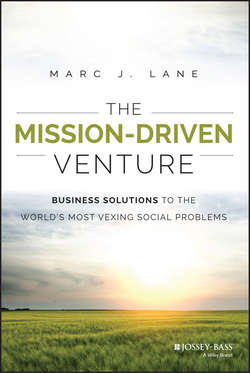Читать книгу The Mission-Driven Venture - Lane Marc J. - Страница 4
Preface
ОглавлениеGovernments and nonprofit organizations everywhere have compassionately invested billions in social services, yet, wherever we look, we still face stubborn challenges in education, health care, poverty, unemployment, and the environment. Those challenges are tougher than ever: the world has not yet recovered from unprecedented economic shocks, government spending is unsustainable, and charitable resources are inadequate to fund the deepening problems too many face. While public- and social-sector programming has improved the lives of countless people, so, increasingly, have market-based business initiatives.
Alone and in combination with government and philanthropic efforts, business strategies are effectively addressing the most intractable of social problems. For-profit, social-purpose businesses are defining success in terms of both financial and social returns. Nonprofits are becoming entrepreneurial, supplementing charitable donations and government grants with revenue earned by the businesses they own and run, instrumentalities of mission in their own right. Progressive nonprofits are partnering with each other, and even with for-profits, breaking down cultural barriers, leveraging their competencies, and gaining economies of scale.
A growing number of passionate social entrepreneurs are deploying invested capital to test and develop business opportunities intended to drive positive social change. They are the “restless people,” as journalist David Bornstein describes them, “so relentless in the pursuit of their visions that they will not give up until they have spread their ideas everywhere.”
Many social entrepreneurs train and employ the disadvantaged and disabled. Others are disruptive innovators helping those populations access products and services previously unavailable to them.
While traditional businesses remain committed to their commercial imperative, more than ever, they, too, are intent on generating a demonstrable social or environmental impact. Together, mission-driven ventures and traditional business concerns are learning how to reach and sustain scaled social solutions.
Newly validated business models and entity forms that invite collaboration are emerging, including the low-profit limited liability company (L3C), which, by law, places mission above profits and facilitates foundation funding of charitable and educational businesses, and the benefit corporation, which requires its managers to make decisions not only to enrich its shareholders, but also for the good of society as a whole. Social impact bonds – futures contracts on social impact – provide long-term funds for promising social interventions, transfer risk to private capital markets, and tap into public coffers only when specific social benefits are achieved. Microfinance and microcredit are helping the poorest of the poor become self-sufficient business owners. And worker-owned co-operatives are converting the disenfranchised into self-reliant entrepreneurs.
Mission-driven ventures across the globe prize transparency and accountability. They lead by example. They fill a humanitarian vacuum left by government and charity, and they do so sustainably as only the private sector can.
Still, ventures seeking “impact investment” haven't fully persuaded the institutional investment community of the merits of their case. And their measurement of social performance continues to be inexact, inconsistent, and costly.
Against that dynamic backdrop, The Mission-Driven Venture was written for those who, like me, are in the empowerment business – nascent and seasoned social entrepreneurs; CSR (Corporate Social Responsibility), sustainability, and supply chain managers of companies committed to partnering with mission-driven ventures; nonprofit and foundation leaders; socially conscious consumers, investors, and donors; institutional funders and financial intermediaries; and professionals and consultants. It provides a roadmap of how a mission-driven venture is designed, built, and scaled – and how each of its stakeholders can best contribute to its financial success and operational effectiveness.
Along the way, The Mission-Driven Venture also recounts the life stories of modern-day heroes, people who, for very personal reasons, took on a social challenge as their own and vowed to overcome it through the prudent application of sound business principles. The lessons they learned and the successes they won translate into models worth replicating and adapting. My hope is that their thought leadership will help inform your decisions and inspire your actions.
Marc J. Lane
October 2014
